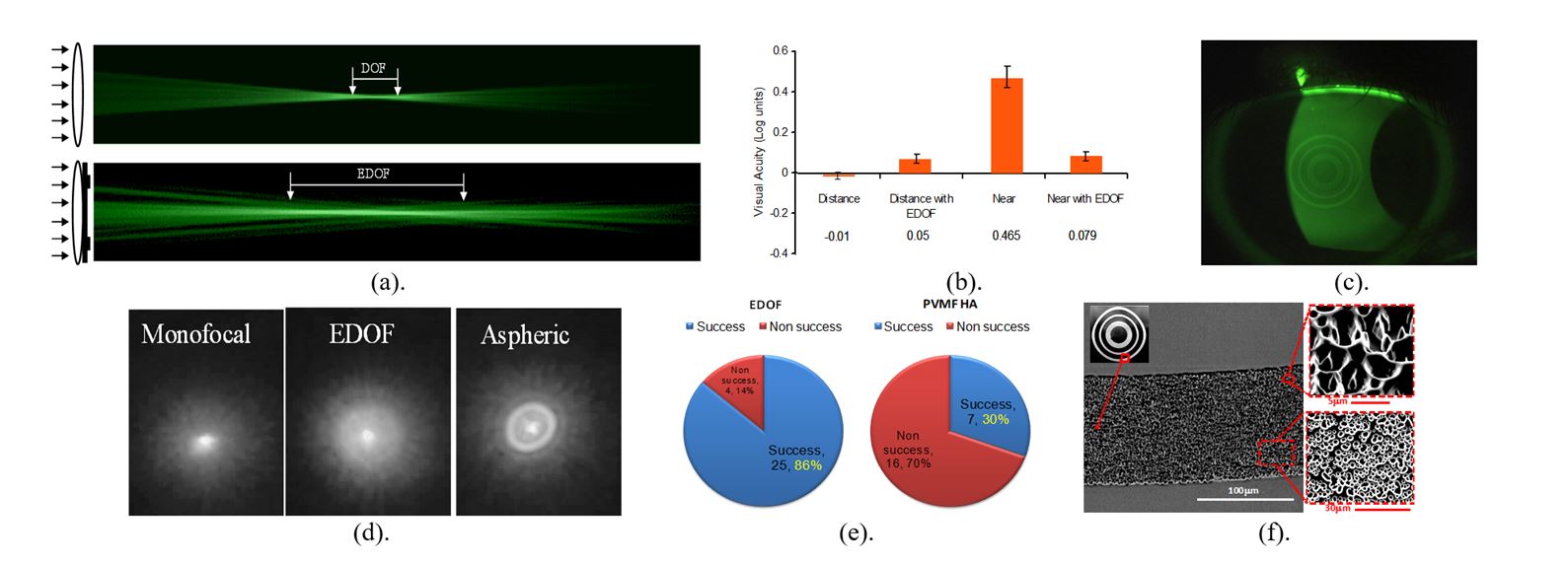Video Article Open Access
Advanced Surface Modification of Ophthalmic Lenses for Visual Problems Correction
Zeev Zalevsky
Faculty of Engineering and the Nanotechnology Center, Bar Ilan University, Ramat-Gan, 52900, Israel
Vid. Proc. Adv. Mater., Volume 2, Article ID 2021-02114 (2021)
DOI: 10.5185/vpoam.2021.02114
Publication Date (Web): 23 Mar 2021
Copyright © IAAM
Graphical Abstract

Abstract
We have developed a unique concept to solve presbyopia and to apply it for spectacles, soft and rigid CL and to infra-ocular lenses [1-3]. The idea is to use the effect of optical interference (rather than refractive or diffractive) for extending the depth of the focus (EDOF) of the lens for about 3 Diopters which allows to have focused imaging over the full field of view without the need of using the accommodation capabilities of the eye (when having presbyopia). The EDOF is obtained by generating transversely large and axially shallow scratches on the surface of the lens modifying the axial interference patterns of rays passing through the aperture of the lens in such a way that EDOF is obtained (the focus of every lens is the point of constructive interference in which all rays passing through the aperture of the lens have exactly the same geometrical path length). Since the scratches are transversely large no chromatic aberrations and energetic losses are induced. Properly treating the surface and modifying the structure inside the scratches allows obtaining optical performance which is not tears sensitive (important for CL). The proposed design also allows obtaining reduced halo effect (very essential for vision in dark conditions as e.g., at night).
Keywords
Presbyopia, interference, extended depth of focus (EDOF), ophthalmology.
References
- Z. Zalevsky, M. Belkin, “Thin spectacles for myopia, presbyopia and astigmatism insensitive vision,” Opt. Express, 2007, 15, 10790-10803.
- A. Zlotnik, Z. Zalevsky, “Extended Depth of Focus Contact Lenses for Presbyopia,” Opt. Lett., 2009, 34, 2219-2221.
- S. Ben Yaish, Z. Zalevsky, “Intra-Ocular Omni-Focal Lens with Increased Tolerance to Decentration & Astigmatism,” J. of Ref. Surg., 2010, 26, 71.
Biography
Zeev Zalevsky received his B.Sc. and direct Ph.D. degrees in electrical engineering from Tel-Aviv University in 1993 and 1996 respectively. Zeev is currently a full Professor and the Dean of engineering in Bar-Ilan University, Israel. His research involves optical super resolution, biomedical optics and nano-photonics/technology. Zeev has published more than 850 papers, 9 books, 30 book chapters and about 100 patents. Zeev gave 600 conference presentations with more than 200 invited/keynote/plenary talks. Zeev is a fellow of many large scientific societies as SPIE, OSA, IEEE, EOS, IOP, IET, IS&T, NAI and more. For his work he received many national and international prizes as Krill prize, ICO prize, SAOT prize, Juludan prize, Taubelnblatt prize, young investigator prize in nanotech, International Wearable Technologies Innovation World Cup, Image Engineering Innovation Award, NANOSMAT prize, SPIE prism award, International Photonic Award, Horace Furumoto award, Asian Advanced Materials Award, Edison Award and more.
Video Proceedings of Advanced Materials

Upcoming Congress



